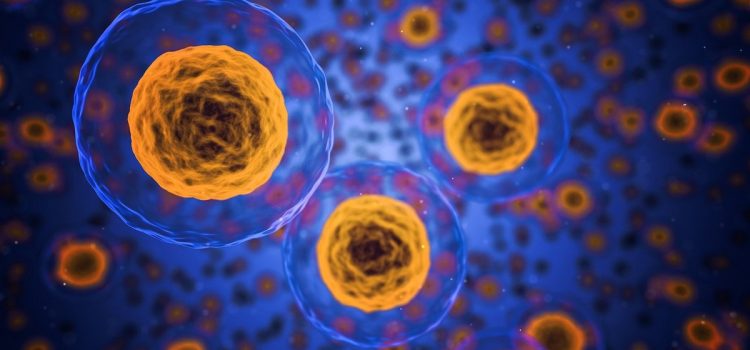

This article is an excerpt from the Shortform book guide to "The Vital Question" by Nick Lane. Shortform has the world's best summaries and analyses of books you should be reading.
Like this article? Sign up for a free trial here.
When, where, and how did the first cells on Earth arise? How can we fill in the gaps left by the fossil record and genetics?
In The Vital Question, biochemist Nick Lane explores the biochemistry of cells and speculates about how life might have developed on the very young Earth. He discusses the genetic history and what cells require. Then, he uses that information to hypothesize about the earliest cells.
Continue reading to take a journey deep into prehistory—and into the ocean.
The First Cells on Earth
Evolutionary biology has a “chicken or egg” problem. The question is which came first—self-replicating molecules such as DNA or the organic structures of the cell within which those molecules thrive. Lane argues that researchers have ignored this problem by focusing exclusively on the lineage of the DNA molecule. But, the origins of life can’t be fully understood without also discussing where it began and what sort of environmental conditions gave rise to the first cells on Earth. The fossil record and genetic evidence give some clues to the path on which life developed, but there are gaps in our knowledge that scientists can’t fill via direct observation.
Consider what our world was like four billion years ago. The chemical makeup of ancient zircon crystals shows that the young Earth was temperate and wet, but the atmosphere was primarily carbon dioxide, nitrogen, and water vapor. There wasn’t any free oxygen yet, since that’s a byproduct of organic respiration. The earliest geological evidence of the chemistry of life dates back 3.8 billion years, but the first microfossils of single-celled organisms don’t appear until 300 million years later. Lane admits that much of this is still up to debate because, that far back in prehistory, the dividing line between biochemistry and geochemistry is fuzzy since there are some naturally occurring chemical reactions that can be mistaken for signs of simple life.
(Shortform note: The gray area between biochemistry and geochemistry has stymied the search for life on other planets. When the two Viking spacecraft landed on Mars, they tested the soil for signs of life but the results were inconclusive. Though one experiment tested positive for lifelike metabolic processes, another showed an absence of organic compounds, leading scientists to speculate that Martian soil contains inorganic substances that mimic organic chemical reactions. Likewise, in 1996, a meteorite originating from Mars was found to have what appeared to be microfossils, but doubtful scientists pointed out that those structures could have been produced by geological crystal-forming events.)
Genetic History
Whereas geologists look to the fossil record and traces of ancient chemical reactions to study the origins of life, biologists chart life’s ancient lineage by comparing the genomes of different modern species. But, here, we run into a different problem. Genes reveal the history of evolution via commonalities in species’ DNA—for example, it’s believed that humans and chimpanzees are closely related because we share 99% of the same genetic code.
However, Lane explains that, for most single-celled life, this doesn’t work because of a process called lateral gene transfer. In essence, microbes swap DNA with each other, creating hybrids and Frankenstein’s monsters on the fly. This makes it impossible to use shared DNA to trace the history of bacterial species since any DNA within a bacterium could have come from its parent or a completely different neighbor.
| The Advantages of Microbial Evolution Since the time of Lane’s writing, advances in computers are making it possible to track the transmission of genes between different species of bacteria. The results suggest that how useful a gene is determines its likelihood of being transferred. A troubling implication of the study is that if a species of bacteria develops a resistance to antibiotics, it’s able to pass that genetic resistance to other bacterial species. While complex life forms like ourselves can only pass genes to our descendants, harmful bacteria can pass their mutations to neighboring species, accelerating microbial evolution faster than complex life can adapt to protect itself. While lateral gene transfer hasn’t been observed in higher, complex forms of life, something like it may have occurred in a species of fruit flies that diverged from their cousins 13 million years ago. These flies have DNA that may have been inserted into their genome by contact with a virus. An example of a complex life form picking up a beneficial gene from a bacterium is the spider mite Tetranychus urticae, which stole the ability to safely digest cyanide from an invading bacterial genome. |
What microbial DNA shows for certain is that, deep in prehistory, single-celled organisms split into two separate domains of life—bacteria and the more recently discovered archaea, simple life forms that look like bacteria but are very different on a genetic and molecular level. Since archaea share some similarities with multicellular life on the microscopic level, it was first believed that they were either an offshoot or a “missing link” in our evolutionary line, though Lane argues that the story is actually more complex.
(Shortform note: Though archaea were recognized as a separate domain of life in 1977, many biologists including Lane still refer to all simple, single-celled life as “bacteria” for simplicity’s sake. Archaea are distinct from bacteria in that their cell walls lack peptidoglycan, instead relying on a variety of other substances and chemical structures. Archaea tend to inhabit harsher environments than bacteria, such as those that are extremely hot or cold, or have large amounts of toxic chemicals. While archaea and bacteria both reproduce by cell division, bacterial offspring can survive as dormant spores, whereas those of archaea cannot.)
How to Make a Cell
To deduce how life began, biologists like Lane have to reverse-engineer our primordial single-celled ancestors. Working backward through time, it’s possible to hypothesize the traits of the very first microbial life. Dubbed the last universal common ancestor, the first cell contained only the biological features found in all living cells today but not characteristics that evolved later—such as different species’ internal chemistry or the different ways that cells divide. Lane discusses the minimum structural requirements a living cell needs to survive and reproduce, the environmental factors that must have been present for life to arise from nonliving matter, and the sequence of events that may have taken place to ignite the first spark of life.
What a Cell Needs
The most easily identifiable parts of a cell are the self-replicating molecules that encode its chemical blueprint—DNA and RNA. The next requirement that makes a cell a “cell” is a physical structure to define its boundaries. Beyond that, a cell needs a steady supply of food and energy, as well as some kind of catalyst for metabolic reactions (which break the food apart into building blocks and ATP). Finally, the cell needs a way to eject the waste products of its metabolism so that they don’t clog the cell with useless matter. Lane says all these features had to be there from the start, which returns us to the question of which came first—the structure of the cell or the DNA blueprints for how to build one?
Lane suggests that the answer to the riddle is that life arose in an environment where many of its necessary components already existed in a nonliving form. We know that matter can spontaneously organize itself, given enough energy input.
Cells Without Borders
While the same basic organic compounds are common to all known forms of life, one trait that isn’t shared between bacteria and archaea is the structure of the outer cell wall. Both have them, but both have significant differences on the molecular level—differences strong enough to suggest that the two domains’ cell wall structures developed independently from each other in a case of parallel evolution. From this, Lane concludes that the original cell didn’t have an organic cell wall at all—the cell wall evolved later in the evolutionary time frame. Since the first cell had to have some kind of boundary, that boundary must have been inorganic, perhaps even geological in nature, which gives our first clue as to where life may have formed.
The second clue to where life may have formed is the electrochemical membrane gradient that’s used to power all living cells. The original cell must have been born in a place where such gradients can occur naturally. Finally, there’s the requirement for the cell to metabolize food into the molecular building blocks it needs to grow and reproduce. In modern cells, the flow of food and waste into and out of the cell is guided by complex, specialized proteins that have evolved over eons. Lane argues that before life began, those specialized proteins couldn’t have evolved yet, so something else must have directed that flow—perhaps a stream of heated organic compounds funneled through a constricted passage.
Where Life Began
Because of these clues, Lane believes that a certain chain of events took place that created the housings for the first living cells. First, inside a porous geologic formation with microscopic chambers the size of tiny cells, natural electrical gradients combined carbon and other common elements into organic molecules. Those molecules clustered in the formation’s nooks and crannies, where a steady stream of heat prompted them to self-organize into even more complex patterns. Eventually, some of these molecules coalesced into chains that are capable of copying themselves, while others formed the basis of internal cellular structures. But, where in the world could this sequence of events have taken place?
Lane writes that taking into account the first living cells’ chemical and geophysical requirements narrows the field of possible locations where life could have begun to a single, most likely candidate: alkaline hydrothermal vents at the bottom of Earth’s primordial ocean. Lane describes the nature of these hydrothermal vents, why they were ideal for the development of life, and a scenario by which life may have evolved the ability to break free from these vents and survive in the open ocean.
Alkaline hydrothermal vents are different from the more commonly known “black smoker” underwater volcanic vents that exist along oceanic ridges where continental plates are pulling apart. Alkaline vents are farther from the rift, but where molten rock from the mantle is still relatively close to the Earth’s crust. Seawater filters down through the crust, where it reacts with the mantle and spews back upward, bringing a payload of hydrogen gas and minerals from beneath the Earth’s surface. These vents create porous towers of rock that are rushing with heated water rich in chemicals—conditions that are perfect for organic compounds.
Life in the Vents
According to Lane, the micropores in these vents were the ideal cell-like structures in which the chemical precursors of life could collect. The material found in the walls of these vents, such as iron sulfide and iron hydroxide, acted as inorganic catalysts for the basic metabolic reaction of life—the conversion of hydrogen and carbon dioxide into a variety of organic molecules until finally being expelled as methane. The flow of warm, chemically saturated water provided all the energy and fuel this burgeoning ecosystem needed, while also providing a motive force to flush away the buildup of waste from the first organic reactions.
Lane goes on to point out that oceanic chemistry was different four billion years ago, and this was significant to the formation of life. The seas of that time had no dissolved oxygen, but they were rife with carbon dioxide, meaning they were far more acidic than today. The water emerging from these vents, however, was strongly alkaline. The fatty acids created by the vents’ ongoing chemistry congealed into a membrane-like barrier between the vents’ porous interior and the seas outside. The iron that coated the walls of the vents conducted protons from the acidic (positively charged) ocean to the alkaline (negatively charged) water in the vents’ pores, creating the electrochemical gradient that still powers all living cells today.
In other words, the physical properties of alkaline vents provided all the necessary pieces for living cells to develop within them. All that was needed now for life to start was for the proteins and organic molecules inside to organize into patterns that could store information and replicate themselves. Once that happened, life was ready to emerge, spreading throughout the alkaline pores in life’s original hydrothermal home.

———End of Preview———
Like what you just read? Read the rest of the world's best book summary and analysis of Nick Lane's "The Vital Question" at Shortform.
Here's what you'll find in our full The Vital Question summary:
- Why genetics alone aren't enough to explain why cells function as they do
- A theory on where all complex life originated from
- An explanation of how cells work and are made






